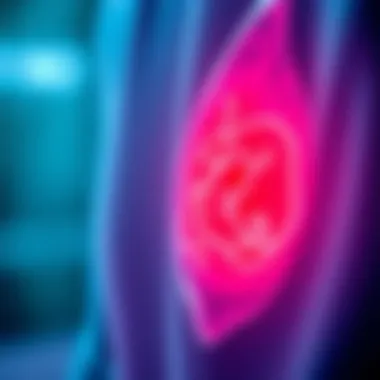Adenocarcinoma Recurrence: Influencing Factors


Intro
Adenocarcinoma is a notable type of cancer that emerges from glandular tissues, which are parts of the body responsible for secretion. The recurrence rates of this cancer are, unfortunately, a pressing concern for patients and their families. Understanding why this type of cancer tends to return after treatment is crucial for providing better outcomes down the line.
Recurrence means that the cancer comes back after treatment has seemingly cured the patient. This can happen in the same place or spread to other regions in the body. A patient’s journey doesn’t end with surgery, radiation, or chemotherapy; it often leads into a phase of careful monitoring and evaluating various elements that could influence the return of the disease. So, what are the underlying factors that contribute to adenocarcinoma recurrence?
This article will peel back the layers on adenocarcinoma recurrence rates, discussing not just the technical aspects but also the real-world implications for those facing this diagnosis. We'll chat about biological mechanisms, treatment strategies, and the importance of diligent follow-up care. Additionally, patient demographics and genetic factors, which can play both subtle and prominent roles, will be examined. Grab a cup of tea, and let's get into it.
Foreword to Adenocarcinoma
Adenocarcinoma is a term that rings alarm bells in the healthcare community. Understanding this form of cancer is paramount for a host of reasons. First off, adenocarcinoma is among the most common cancers affecting several organs, including the lungs, pancreas, and breast. By navigating the intricacies surrounding this ailment, particularly its recurrence rates, patients and healthcare professionals alike can form a more complete picture of risk factors and treatment outcomes. The stakes are high here; recurrence can drastically alter a patient’s prognosis and treatment options.
Definition of Adenocarcinoma
To grasp the severity of adenocarcinoma, one must first understand what it actually is. This cancer originates in glandular epithelial cells, which are responsible for producing and secreting substances like mucus, hormones, or other fluids. The “glandular” descriptor is key; it signifies a specific origin that distinguishes adenocarcinoma from other types of malignancies. More technically, adenocarcinoma falls under the umbrella of carcinomas, which are cancers that arise from epithelial tissues. So, when we discuss adenocarcinoma, we are focusing on a wide spectrum of possible cancers, all derived from glandular cells.
Common Types and Locations
Adenocarcinoma isn't a one-size-fits-all kind of cancer. One might find various forms of it in different parts of the body. Some common types include:
- Lung Adenocarcinoma: Predominantly found in smokers but increasingly seen in non-smokers as well. This type often arises in the peripheral regions of the lungs.
- Pancreatic Adenocarcinoma: This silent killer tends to be diagnosed at an advanced stage, leading to poor prognosis.
- Colorectal Adenocarcinoma: Originating from the colon or rectum, this type has a well-established link to diet and lifestyle factors.
- Breast Adenocarcinoma: Often referred to as invasive ductal carcinoma when it originates in the milk ducts, this type is a significant concern among women.
Understanding the locations and types helps tailor treatment options and follow-up strategies tailored to different variations of the disease.
Importance of Recurrence Research
Research into adenocarcinoma recurrence is where the rubber meets the road. Recurrence rates can signal whether current treatment protocols are effective or if new strategies need to be developed. A deeper dive into the statistics can reveal crucial insights:
- Are certain demographic groups more prone to recurrence?
- What role do genetic factors play in the likelihood of recurrence?
- How can monitoring and follow-up adapt to mitigate risks?
These inquiries are not merely academic; they have real-life implications. Higher recurrence rates can indicate a need for more aggressive treatment and vigilant post-treatment monitoring. In many cases, being informed about risks can help patients make proactive decisions regarding their health, leading to better outcomes.
With adenocarcinoma being so complex in nature, ongoing research into its recurrence is not just beneficial but essential for advancing care and treatment approaches.
With adenocarcinoma being so complex in nature, ongoing research into its recurrence is not just beneficial but essential for advancing care and treatment approaches.
The more we understand adenocarcinoma, the better we can combat its relentless nature. This section sets the stage for further exploration into recurrence rates, the factors influencing them, and the implications for patient care.
Recurrence Rates Overview
Recurrence rates of adenocarcinoma hold considerable importance in the predictive modeling of patient outcomes. Recognizing these rates enables healthcare professionals to devise comprehensive treatment plans and tailor monitoring strategies, ultimately aiming for better long-term survival rates. By exploring recurrence, practitioners and researchers can unlock a treasure trove of insights into the nature of this malignancy and how various factors converge to influence patient trajectories.
Statistical Insights
Delving into the statistics surrounding adenocarcinoma recurrence unveils both startling and enlightening trends. Research indicates that the overall recurrence rates vary somewhat significantly depending on factors such as the tumor’s type, location, and individual characteristics of the patient. To illustrate:
- For colorectal adenocarcinoma, studies have shown recurrence rates varying between 20% to 40%, depending on the stage of the disease at diagnosis.
- Breast adenocarcinoma often witnesses recurrence rates hovering around 15% to 30% within the first ten years post-treatment, with a noted decline in later years.
Deciphering these statistics not just assists in risk stratification but also offers a blueprint for patient management. The variability in recurrence implies that a one-size-fits-all approach is futile and points toward personalized treatment protocols.
Variability in Recurrence Rates
Understanding the intricacies behind the variability in adenocarcinoma recurrence rates is crucial. Numerous elements come into play, influencing the likelihood that a cancer will return post-therapy:


- Tumor Characteristics: Some adenocarcinomas exhibit more aggressive behaviors or higher rates of metastasis. Tumor grade, lymphovascular invasion, and margins of resection are pivotal factors here.
- Treatment Modalities: The modality used in treatment—surgery, chemotherapy, or radiation—can significantly impact recurrence rates. Notably, the combination of therapies usually yields more favorable results than single-modality approaches.
- Patient Demographics: Age, genetic predispositions, and overall health can affect recurrence too. Younger patients may respond differently to treatment, and certain ethnicities might possess genetic factors increasing susceptibility to recurrence.
"Understanding how varied these recurrence rates can be is key to shaping individualized treatment pathways and careful monitoring strategies, as no two patients' journeys are the same."
"Understanding how varied these recurrence rates can be is key to shaping individualized treatment pathways and careful monitoring strategies, as no two patients' journeys are the same."
In essence, variability paints a complex picture of adenocarcinoma recurrence. Each case tells a different story of potential, risk, and the nuanced journey to recovery. These insights compel both patients and healthcare providers to engage in ongoing education and awareness of emerging trends in adenocarcinoma recurrence.
Factors Influencing Recurrence
Recurrence rates of adenocarcinoma aren’t determined by chance; they're shaped by a variety of factors that can make a significant difference in the long-term outcomes for patients. Analyzing these factors is crucial because they help clinicians tailor treatment approaches, optimize monitoring strategies, and enhance patient awareness regarding their specific risks. Each factor contributes uniquely, shedding light on the complex tapestry of cancer recurrence.
Tumor Biology
Tumor biology is at the heart of understanding recurrence. Each adenocarcinoma behaves differently based on its genetic makeup and histological characteristics. Some tumors are more aggressive, exhibiting rapid growth and invasive behavior, leading to higher recurrence rates. For instance, tumors with certain genetic mutations, like KRAS or TP53, can be particularly notorious for their resilience against standard treatment. The biology of a tumor isn't just a backdrop; it's the script that influences how a patient will respond to treatment and, subsequently, the likelihood of recurrence.
Treatment Modalities
Chemotherapy
Chemotherapy plays a pivotal role in the treatment of adenocarcinoma, often being a frontline option after initial surgery. Its ability to target rapidly dividing cancer cells makes it a standard approach. However, not all tumors respond the same way. Some might shrink considerably, while others may resist treatment altogether. The drawback lies in its side effects—nausea, fatigue, and an increased risk of infection—for patients. These factors can weigh heavily on decisions about follow-up treatments and recurrence management.
Radiation Therapy
Radiation therapy is another tool in the box. It targets specific areas, aiming to eliminate residual cancer cells post-surgery. The key characteristic here is precision, and when applied correctly, it can significantly reduce the chance of local recurrence. That said, there's a risk of damage to surrounding tissues, which can lead to long-term complications. Thus, while it can be beneficial, clinicians must weigh the potential wheat against the chaff when recommending this treatment.
Surgery
Surgery serves as a cornerstone in the management of adenocarcinoma, particularly for solid tumors. The unique feature of surgery is that it aims to physically remove the cancerous tissue. The success of surgical intervention often dictates the subsequent recurrence rate. However, factors such as tumor location and staging can impact surgical outcomes. In some cases, complete excision may not be possible, leaving behind microscopic cancerous cells that may lead to recurrence. Post-operative monitoring becomes vital in these scenarios.
Targeted Therapy
Targeted therapy is where the advancements in science come into play. This approach zeroes in on specific molecular targets associated with cancer. The benefits of targeted therapy include fewer side effects compared to traditional chemotherapy and radiation, making it an appealing option for many patients. However, it depends heavily on the specific characteristics of the tumor, which means it’s not always a suitable option for everyone. Despite its promise, limitations in its effectiveness and potential development of resistance can affect its overall contribution to managing recurrence.
Immunotherapy
Immunotherapy represents a newer frontier, harnessing the body’s own immune system to combat cancer. This method can lead to remarkable results for some patients, especially those with unique tumor markers that respond well. It is becoming recognized as an effective way of reducing recurrence risk. However, the unique feature of immunotherapy lies in its variability—while it works wonders for some, others might not see any benefit. This unpredictability can complicate treatment planning, as assessing potential effectiveness before treatment can be tricky.
Patient Demographics
Age
Age has a significant impact on recurrence, as older patients may respond differently to treatments compared to younger individuals. A notable characteristic is that older patients often have more comorbidities, which complicate treatment decisions and may affect their overall prognosis. In terms of recurrence, older age can result in a greater likelihood of recurrence due to these factors and delayed response to therapies.
Gender
Gender differences in cancer biology could also play a role. For instance, male patients might have different recurrence patterns compared to females. Hormonal influences can account for variances in treatment responses, disease progression, and recurrence rates. This aspect underscores the importance of personalized treatment plans that consider gender-specific responses.
Ethnicity
Interestingly, ethnicity can shape recurrence rates as well. Genetic factors associated with different ethnicities may come into play when discussing susceptibility to specific genotypes of adenocarcinoma. For instance, certain ethnic groups may have higher prevalence of particular genetic mutations, influencing the behavior of tumors and, subsequently, recurrence rates.
Socioeconomic Status
Lastly, socioeconomic status is another layer in the exploration of recurrence factors. Patients from lower socioeconomic backgrounds may have limited access to healthcare, affecting their likelihood of receiving timely and appropriate treatments. Additionally, these factors often correlate with worse health outcomes, hence increasing the likelihood of recurrence as they may face barriers in continuous post-treatment monitoring and care.


Genetic Factors
Genetic factors drive the behavior of adenocarcinoma and its tendency to recur. While variations in genetic material can predispose individuals to certain types of cancers, the nuances of these genetic markers can also help in tailoring treatment plans. Understanding an individual's genetics can lead to personalized medicine strategies, improving the outcomes for patients and potentially reducing their recurrence risk.
"To truly combat adenocarcinoma recurrence, understanding these influencing factors is not just beneficial; it's essential. The more we comprehend the nuances of tumor biology, treatments, and patient demographics, the better equipped we are to tailor care and improve outcomes."
"To truly combat adenocarcinoma recurrence, understanding these influencing factors is not just beneficial; it's essential. The more we comprehend the nuances of tumor biology, treatments, and patient demographics, the better equipped we are to tailor care and improve outcomes."
Ensuring that we pay attention to these facets might just pave the way for better management strategies and ultimately, a lower recurrence rate.
Monitoring and Follow-Up
Monitoring and follow-up are crucial pillars in the journey of managing adenocarcinoma. Once treatment is wrapped up, that’s not the end of the line. Patients and healthcare providers must keep a watchful eye on potential recurrence. The impacts of thorough monitoring go beyond just detection; they are integrally linked to improving outcomes and enhancing quality of life.
Early detection of recurrence often leads to a prompt intervention, which can be vital. The notion here is simple: catch it early, treat it swiftly. This proactive approach can significantly shift the trajectory of a patient’s health journey. Regular check-ups allow for timely adjustments in treatment plans and can give peace of mind, allowing patients to navigate their emotional and physical challenges more effectively.
Additionally, a structured follow-up regimen helps in building a solid relationship between patients and their medical teams. This bond fosters better communication, encourages patients to report new symptoms or worries, and makes it a shared mission to tackle any hurdles together.
Importance of Surveillance
Surveillance is not just about keeping tabs; it's about crafting a safety net for patients post-treatment. The safety net functions to enable healthcare teams to notice signs that might escape casual observation. The stakes are high when it comes to adenocarcinoma recurrence, and being attentive can mean the difference between life and death.
Moreover, routine surveillance has been linked to enhanced patient outcomes. Studies suggest that patients undergoing consistent monitoring have better overall survival rates, reinforcing the need for a diligent follow-up schedule. The value of staying ahead of the game cannot be overstated, adding layers of reassurance and structure to the lives of those recovering from adenocarcinoma.
Methods of Monitoring
A variety of monitoring techniques exist, which can include imaging studies and biomarker assessments. Selecting the proper methods entails understanding both the available technologies and the unique needs of the patient.
Imaging Techniques
Imaging techniques are like the eyes of medicine, providing glimpses into the internal workings of the body where trouble might brew. Techniques such as CT scans and MRIs shine a light on any suspicious growths or changes in the body post-treatment, making them popular choices for monitoring recurrence of adenocarcinoma. Their ability to create detailed images of the body’s structures offers crucial insights.
One standout characteristic of imaging techniques is their non-invasive nature, which allows for frequent checks without needing surgical intervention. However, there's a flip side; radiation exposure from frequent scans, particularly with CT scans, can pose some risks. It's a balancing act: reaping the benefits of early detection while keeping patient safety at the forefront.
Biomarkers Assessment
Biomarker assessments are like a blood test peering into molecular clues of what's happening within the body. This approach measures specific proteins or genetic material released into the circulatory system, offering insights into cancer recurrence risks. The versatility of biomarkers is its key characteristic; they can be tailored to an individual’s molecular profile, making them a personalized monitoring tool.
A significant feature of biomarker assessments is their ability to detect recurrence in real-time, often even before imaging reveals any issues. This is critical as it allows for near-instant responses if something abnormal pops up. However, these tests are not universally applicable; not all adenocarcinoma types have identified biomarkers, which can limit their effectiveness. Thus, while biomarkers are a powerful ally, they are most effective when integrated with other monitoring strategies.
In summary, a multi-faceted approach to monitoring, combining both imaging and biomarkers, enriches the understanding and management of adenocarcinoma recurrence. This nuanced strategy underscores the complexities of monitoring in cancer care, focusing not just on survival but also targeting a patient’s overall well-being.
Case Studies and Clinical Trials
Analyzing Recurrence in Specific Cases
Examining individual case studies offers a detailed view of how adenocarcinoma manifests, progresses, and recurs in various patients. Each case is unique, influenced by a multitude of factors ranging from genetics to environment. By analyzing recurrence in specific instances, researchers can identify patterns that may not surface in larger clinical trials. For instance, the recurrence rate of colorectal adenocarcinoma may differ significantly between two patients of the same age but different genetic backgrounds.
Some key elements analyzed in such cases include:
- Treatment history: Including all surgeries, chemotherapies, or radiations previously administered.
- Patient comorbidities: Existing health conditions can greatly impact recovery and recurrence.
- Tumor characteristics: Size, grade, and specific molecular markers all contribute to understanding recurrence probability.
"Personalized approaches, often cited in case studies, highlight how precision in treatment can lead to better outcomes in recurrence management."


"Personalized approaches, often cited in case studies, highlight how precision in treatment can lead to better outcomes in recurrence management."
Specific cases also guide healthcare practitioners in developing tailored treatment plans. They can glean insights on factors like timing of interventions and the effectiveness of adjuvant therapies, which inform patient counseling and potential clinical pathways.
Emerging Trends from Clinical Trials
Clinical trials provide a broader perspective on adenocarcinoma recurrences, frequently examining large cohorts to determine effectiveness of treatment strategies. Recent advancements show a shift toward innovative practices, including:
- Immunotherapy: Trials are exploring how immune checkpoint inhibitors, like pembrolizumab, impact recurrence rates by enhancing the body's natural defenses against tumor cells.
- Targeted therapies: Ongoing studies are focusing on specific genetic mutations, such as KRAS, which may drive recurrence patterns in particular tumor types. By linking treatment responses to molecular subtypes, trials are working to refine personalized medicine.
- Combination treatments: The synergy of various treatment modalities, such as chemotherapy alongside targeted therapy, is under thorough investigation to ascertain effective strategies that may lower recurrence stakes.
The findings from these trials often reshape clinical practices. For example, if a trial finds a significant reduction in recurrence rates with a new treatment modality, guidelines are likely to evolve, incorporating these data-driven insights.
For further reading on similar topics, consider visiting NCI, ClinicalTrials.gov, or reviews on academic platforms like PubMed.
Future Directions in Adenocarcinoma Research
The landscape of adenocarcinoma treatment is evolving, driven by the necessity to improve patient outcomes and reduce recurrence rates. As we advance, focusing on future directions becomes crucial for not just researchers but also healthcare professionals and patients who seek better management options. This section adresses notable innovations and personalized methods that could shape the way we approach adenocarcinoma in the years to come.
Innovations in Treatment Approaches
In recent years, the oncology field has witnessed remarkable advances in treatment strategies for adenocarcinoma. Innovative therapies show considerable promise in enhancing efficacy while minimizing side effects.
- Targeted Therapy: This approach involves using drugs that specifically target cancer cell mechanisms. For adenocarcinoma, certain treatments aim at specific mutations, like the use of drugs for epidermal growth factor receptor (EGFR) mutations. These therapies have demonstrated an ability to improve survival rates significantly.
- Immunotherapy: Harnessing the body's immune system has emerged as a strong weapon against adenocarcinoma. Agents such as checkpoint inhibitors push the immune system to recognize and destroy cancer cells effectively. Early results from trials indicate that this might lead to durable responses in a subset of patients.
- Combination Therapies: Researchers are increasingly looking at combining traditional therapies with newer methods to improve patient outcomes. For instance, a mix of chemotherapy and immunotherapy could potentially yield synergistic effects, tackling the disease from multiple angles.
Utilizing these innovative approaches is not just about treating the cancer but also about improving the quality of life for patients, reducing the recurrence likelihood.
Personalized Medicine in Recurrence Management
The idea of personalizing treatment plans based on an individual's characteristics, particularly genetic makeup, is gaining traction in managing adenocarcinoma. Personalized medicine tailors therapies that can lead to higher effectiveness and lower chances of recurrence.
- Genomic Profiling: This process allows clinicians to understand the unique genetic signatures of the cancer. It helps in identifying which treatments will be most effective for a specific patient’s adenocarcinoma. For example, a patient with high microsatellite instability may respond better to immunotherapy than conventional chemotherapy.
- Biomarkers Utilization: Identifying specific biomarkers can inform treatment decisions early in the management process, offering an opportunity to modify therapies proactively. Strategies that take biomarkers into account can often help predict recurrence risk more accurately, guiding clinicians toward more effective follow-up care.
- Tailored Follow-Up Plans: Plans that consider a patient's individual risk factors, genetic data, and treatment history can lead to more personalized surveillance strategies. This method enables healthcare teams to customize monitoring intervals and methods that align with recurrence likelihood.
Personalized medicine holds the potential to flip the script on adenocarcinoma recurrence. By leveraging individual genetic differences, we can craft treatments that resonate with the unique biological footprints they leave behind.
Personalized medicine holds the potential to flip the script on adenocarcinoma recurrence. By leveraging individual genetic differences, we can craft treatments that resonate with the unique biological footprints they leave behind.
Guying future directions in research, both innovative treatment methods and personalized strategies point towards a more sophisticated understanding of adenocarcinoma and its behavior. As we grasp these developments, it becomes clear that the goal is not only to manage the disease but to significantly diminish its threat to patient health.
For further reading, consider visiting National Cancer Institute for updated studies on recent advancements in cancer treatments and recurrence management.
Ending
The examination of adenocarcinoma recurrence rates is a vital pursuit within oncological research and patient care. Understanding the elements that contribute to these recurrence patterns can have profound implications for treatment modality and patient outcomes. This article has provided a detailed exploration of various factors influencing recurrence, offering a well-rounded view of the landscape surrounding adenocarcinoma.
Summarizing Key Insights
In summary, it’s clear that adenocarcinoma is not a one-size-fits-all disease. Key insights drawn from our discussions include:
- Variability: Recurrence rates differ considerably depending on several factors including the tumor’s biological behavior and the specific site of origin.
- Treatment Influence: The choice of treatment, whether it’s chemotherapy, surgery, or targeted therapy, plays a significant role in lowering the chances of recurrence.
- Biological Mechanisms: Understanding the underlying genetic and molecular aspects of adenocarcinoma allows for better prediction of recurrence and development of customized treatment plans.
- Demographic Factors: Variations in age, gender, and even socioeconomic status can subtly change the dynamics of recurrence.
"The more we understand adenocarcinoma recurrence, the better we can prepare tailored strategies to fight it."
"The more we understand adenocarcinoma recurrence, the better we can prepare tailored strategies to fight it."
Implications for Future Care
Looking ahead, the implications of our findings are multifaceted:
- Enhanced Monitoring: Post-treatment surveillance through targeted imaging and biomarker assessments can help catch recurrences early, potentially leading to better prognoses.
- Personalized Treatment Plans: As research in personalized medicine progresses, the emphasis on individual genetic profiles will allow for treatments that are more effective and less likely to lead to recurrence.
- Education and Awareness: For both practitioners and patients, understanding the signs and risk factors associated with recurrence is crucial. Knowledge is power in the battle against cancer.
- Research Investment: Continuous funding and support for research into adenocarcinoma can yield new insights, fostering innovative approaches to treatment that could effectively reduce recurrence rates.
Overall, careful attention to the nuances of adenocarcinoma recurrence can enrich clinical practices and advance the care pathway for patients navigating this complex illness.







